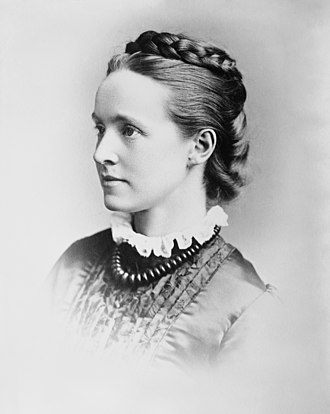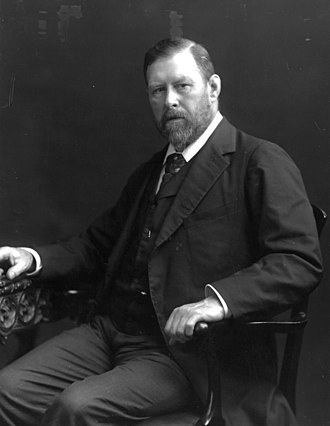
Early life
Millicent Fawcett was born on 11 June 1847 in Aldeburgh to Newson Garrett, a businessman from nearby Leiston, and his London wife Louisa (née Dunnell). She was the eighth of their ten children.
According to the Stracheys: “The Garretts were a close and happy family in which children were encouraged to be physically active, read widely, speak their minds, and share in the political interests of their father, a convert from Conservatism to Gladstonian Liberalism, a combative man, and a keen patriot.”
As a child, Millicent’s elder sister Elizabeth Garrett Anderson, who became Britain’s first female doctor, introduced her to Emily Davies, an English suffragist.
In her mother’s biography, Louisa Garrett Anderson quotes Davies as saying to her mother, to Elizabeth and to Millicent: “It is quite clear what has to be done. I must devote myself to securing higher education, while you open the medical profession to women. After these things are done, we must see about getting the vote.” She then turned to Millicent: “You are younger than we are, Millie, so you must attend to that.”
In 1858, Millicent was sent to London with her sister Elizabeth to attend a private boarding school in Blackheath. Their sister Louise took her to the sermons of Frederick Denison Maurice, a socially aware and less traditional Anglican priest, whose opinions influenced her view of religion.
In 1865, Millicent attended a lecture by John Stuart Mill. In 1866, she and Emily Davies supported the Kensington Society by collecting signatures for a petition asking Parliament to enfranchise women householders.
Married life
John Stuart Mill introduced Millicent to many other women’s rights activists, including Henry Fawcett, a Liberal Member of Parliament who had intended to marry her sister Elizabeth before she decided to focus on her medical career.
Millicent and Henry married on 23 April 1867. Henry had been blinded in a shooting accident in 1858 and Millicent acted as his secretary.
Their marriage was said to be based on “perfect intellectual sympathy”, as Millicent pursued a writing career while caring for Henry and ran two households, one in Cambridge, one in London. The family had some radical beliefs in support of proportional representation, individualistic and free trade principles, and opportunities for women.
In 1858, their only child, Philippa Fawcett, was born and was much encouraged by her mother in her studies. In 1890, Philippa became the first woman to obtain top score in the Cambridge Mathematical Tripos exams.
In 1868, Millicent joined the London Suffrage Committee and in 1869 spoke at the first public pro-suffrage meeting held in London. In March 1870 she spoke in Brighton, her husband’s constituency. As a speaker she was said to have a clear voice.
In 1870, Millicent published her short Political Economy for Beginners, which was “wildly successful”, running through 10 editions in 41 years. In 1872, she and her husband published Essays and Lectures on Social and Political Subjects, containing eight essays by Millicent. In 1875 she co-founded Newnham Hall and served on its council.
Despite many interests and duties, Millicent, along with her sister Agnes, raised four of their cousins, who had been orphaned early in life: Amy Garrett Badley, Fydell Edmund Garrett, Elsie Garrett (later a prominent botanical artist in South Africa), and Elsie’s twin, John.
After Millicent‘s husband died on 6 November 1884, she temporarily withdrew from public life, sold both family homes and moved with Philippa to the house of her sister Agnes. When she resumed work in 1885, she began to concentrate on politics and was a key member of what became the Women’s Local Government Society.
Originally a Liberal, she joined the Liberal Unionist party in 1886 to oppose Irish Home Rule. Millicent, like many English Protestants, felt that allowing home rule for Catholic Ireland would hurt England’s prosperity and be disastrous for the Irish.
In 1891, Millicent wrote the introduction to a new edition of Mary Wollstonecraft‘s book A Vindication of the Rights of Woman which reasserted the reputation of the early feminist philosopher and claimed her as an early figure in the struggle for the vote.
Millicent was granted an honorary doctorate of law by the University of St Andrews in 1899.
Political activism
Millicent began her political career at the age of 22, at the first women’s suffrage meeting. After the death of Lydia Becker, she became leader of the National Union of Women’s Suffrage Societies (NUWSS), Britain’s main suffragist organisation.
Politically Millicent took a moderate position, distancing herself from the militancy and direct actions of the Women’s Social and Political Union (WSPU), which she believed would harm women’s chances of winning the vote by souring public opinion and alienating members of Parliament.
Despite the publicity for the WSPU, the NUWSS with its slogan “Law-Abiding suffragists” retained more support. By 1905, Millicent‘s NUWSS had 305 constituent societies and almost 50,000 members, compared with the WSPU’s 2,000 members in 1913.
Millicent mainly fought for women’s suffrage and found home rule “a blow to the greatness and prosperity of England as well as disaster and… misery and pain and shame”.
She explained her disaffiliation from the more militant movement in her book What I remember:
I could not support a revolutionary movement, especially as it was ruled autocratically, at first, by a small group of four persons, and latterly by one person only…. In 1908, this despotism decreed that the policy of suffering violence, but using none, was to be abandoned. After that, I had no doubt whatever that what was right for me and the NUWSS was to keep strictly to our principle of supporting our movement only by argument, based on common sense and experience and not by personal violence or lawbreaking of any kind.
The South African War gave a chance to Millicent to share female responsibilities in British culture. She was nominated to lead a commission of women sent to South Africa, sailing there in July 1901 with other women “to investigate Emily Hobhouse‘s indictment of atrocious conditions in concentration camps where the families of the Boer soldiers were interned.”
No British women had been entrusted before with such a task in wartime. Millicent fought for the civil rights of the Uitlanders “as the cause of revival of interest in women’s suffrage”.
She had backed countless campaigns over many years, for instance to curb child abuse by raising the age of consent, criminalise incest and cruelty to children within the family, end the practice of excluding women from courtrooms when sexual offences were considered, stamp out the “white slave trade”, and prevent child marriage and the introduction of regulated prostitution in India.
Millicent campaigned to repeal the Contagious Diseases Acts, as reflecting sexual double standards. They required prostitutes to be examined for sexually transmitted diseases and if found to have passed disease to their clients, to be imprisoned. Women could be arrested on suspicion of being a prostitute and imprisoned for refusing consent to examinations that were invasive and painful.
The men who infected the women were not subject to the Acts, which were repealed through campaigning by Millicent and others. She believed such double standards would never be erased until women were represented in the public sphere.
She wrote three books, one co-authored with her husband, and many articles, some published posthumously. Her Political Economy for Beginners went into ten editions, sparked two novels, and appeared in many languages.
One of her first articles on women’s education appeared in Macmillan’s Magazine in 1875, the year when her interest in women’s education led her to become a founder of Newnham College for Women in Cambridge. There she served on the college council and backed a controversial bid for all women to receive Cambridge degrees. Millicent regularly spoke at girls’ schools, women’s colleges and adult education centres.
In 1904, she resigned from the Unionists over free trade, when Joseph Chamberlain gained control in his campaign for tariff reform.
When the First World War broke out in 1914, the WSPU ceased all activities to focus on the war effort. Millicent‘s NUWSS replaced her political activity with support for hospital services in training camps, in Scotland, Russia and Serbia, largely because the organisation was markedly less militant than the WSPU.
The WSPU was called jingoistic for its leaders’ strong support for the war. While Millicent was no pacifist, she risked dividing the organisation if she ordered a halt to the campaign and diverted NUWSS funds to the government as the WSPU had.
The NUWSS continued to campaign for the vote during the war and used the situation to its advantage by pointing out the contribution women had made to the war effort. She held her post until 1919, a year after the first women had received the vote under the Representation of the People Act 1918. After that, she left the suffrage campaign and devoted time to writing books, including a biography of Josephine Butler.
Later life and Death
In 1919 Millicent was awarded an honorary doctorate from the University of Birmingham. In the 1925 New Year Honours she was appointed Dame Grand Cross of the Order of the British Empire (GBE).
Millicent Fawcett died on August 5, 1929, at her London home in Gower Street. She was cremated at the Golders Green Crematorium, although the final resting place of her ashes is unknown.
In 1932, a memorial to Millicent, alongside that of her husband, was unveiled in Westminster Abbey with an inscription: “A wise constant and courageous Englishwoman. She won citizenship for women.”

